Microwave Field-Induced Changes in Raman Modes and Magnetic Force Images of Antiferromagnetic NiO Films
Abstract
1. Introduction
2. Structural Characterization of the Virgin Films
2.1. Film Growth, XRD, and RBS Characterization
2.2. Atomic Force Microscopy Characterization
2.3. Micro-Raman Characterization
2.4. Magnetic Force Microscopy Characterization
3. Results
3.1. Influence of MWs on MFM Images in Virgin NiO Films
3.2. Influence of Microwaves on Raman Modes in Virgin NiO Films
4. Discussion and Conclusions
Author Contributions
Funding
Institutional Review Board Statement
Informed Consent Statement
Data Availability Statement
Conflicts of Interest
Appendix A. Control Raman Experiments on the MgO and Al2O3 Substrates
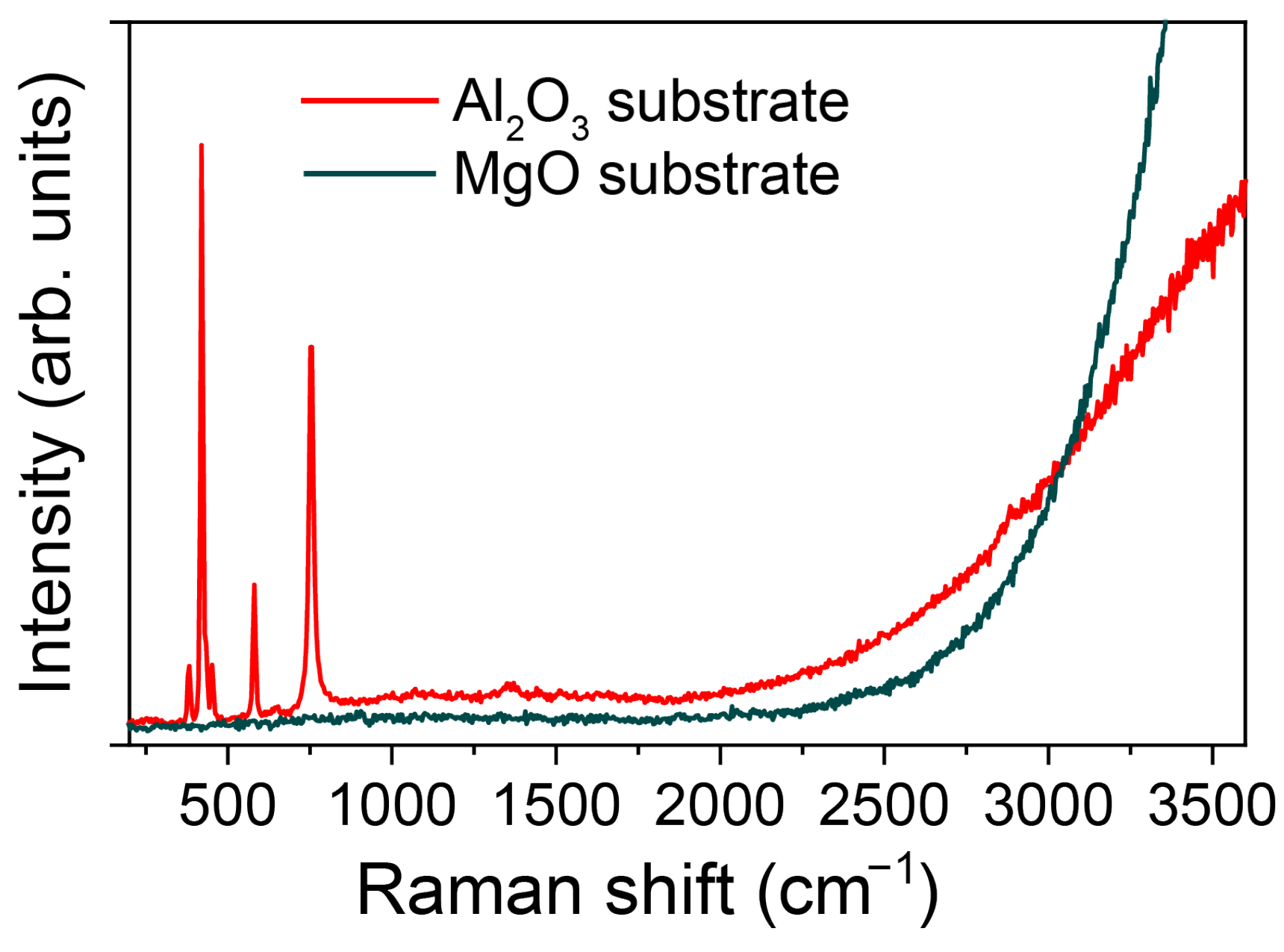
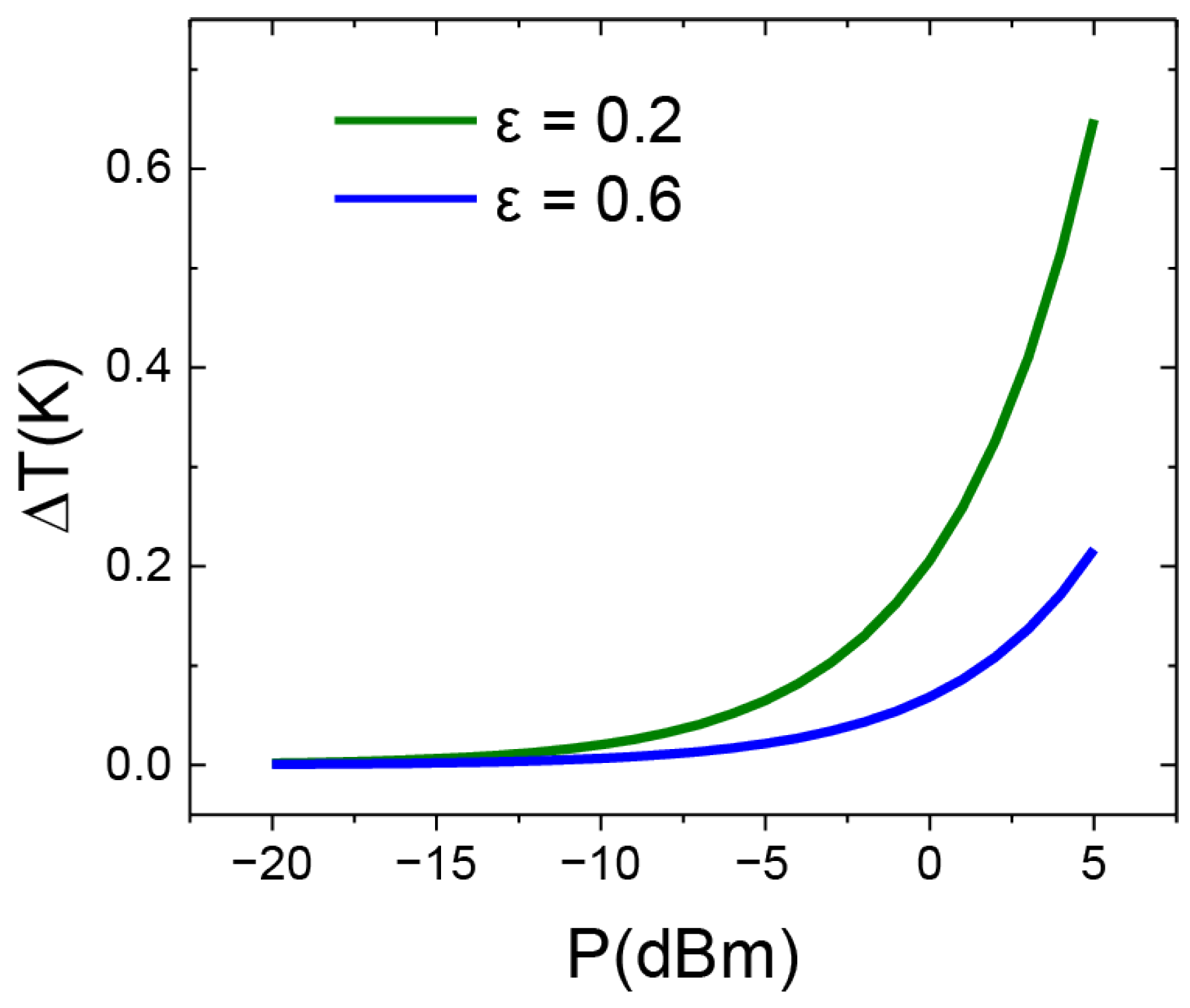
Appendix B. COMSOL Simulations on the Temperature Provided by the MW Heating on the Sample
Appendix C. Microwave Transmission Measurements as a Function of Power
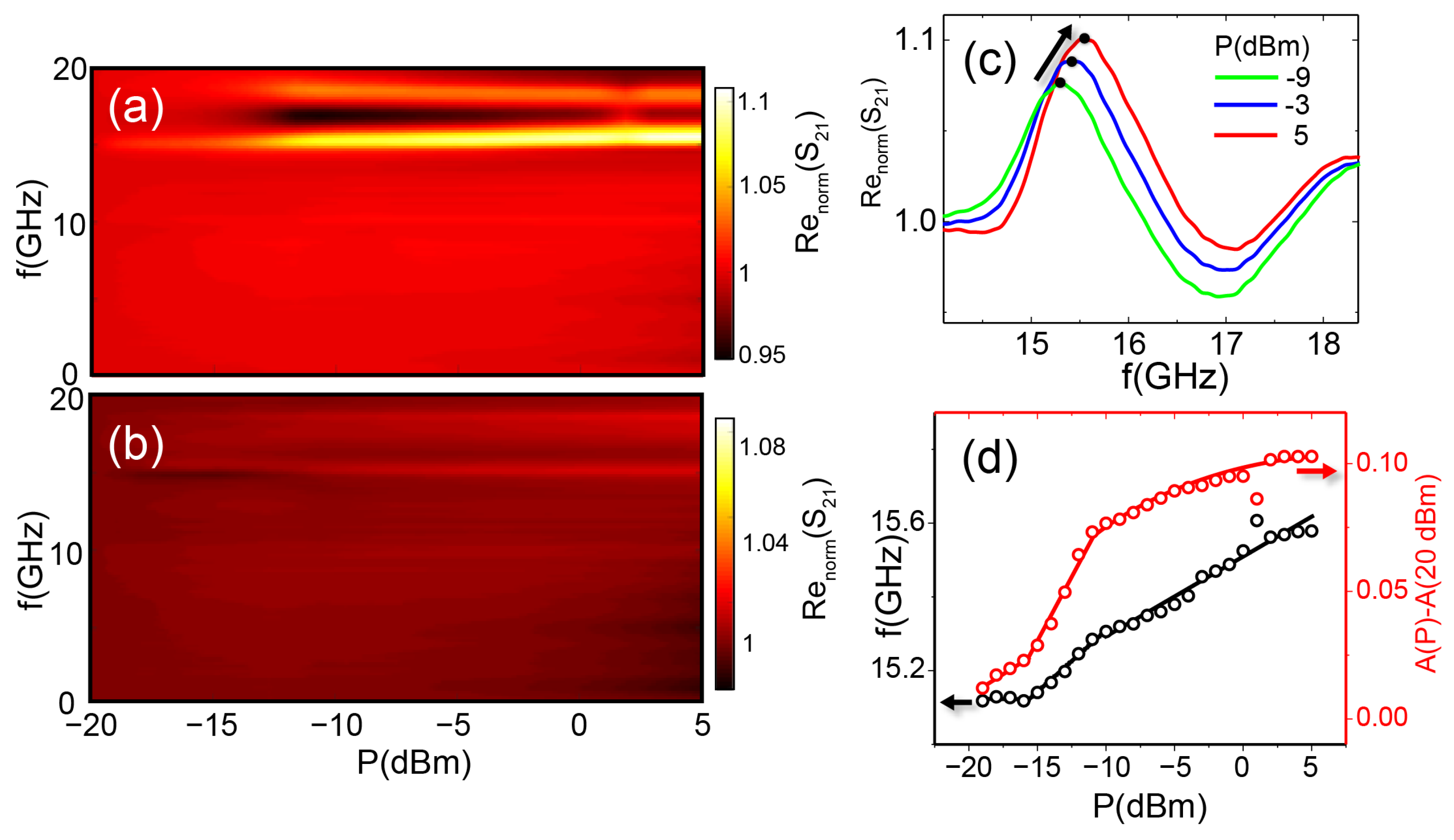
References
- Satoh, T.; Cho, S.J.; Iida, R.; Shimura, T.; Kuroda, K.; Ueda, H.; Ueda, Y.; Ivanov, B.A.; Nori, F.; Fiebig, M. Spin Oscillations in Antiferromagnetic NiO Triggered by Circularly Polarized Light. Phys. Rev. Lett. 2010, 105, 077402. [Google Scholar] [CrossRef] [PubMed]
- Moriyama, T.; Hayashi, K.; Yamada, K.; Shima, M.; Ohya, Y.; Ono, T. Intrinsic and extrinsic antiferromagnetic damping in NiO. Phys. Rev. Mater. 2019, 3, 051402. [Google Scholar] [CrossRef]
- Kampfrath, T.; Sell, A.; Klatt, G.; Pashkin, A.; Mährlein, S.; Dekorsy, T.; Wolf, M.; Fiebig, M.; Leitenstorfer, A.; Huber, R. Coherent terahertz control of antiferromagnetic spin waves. Nat. Photonics 2010, 5, 31–34. [Google Scholar] [CrossRef]
- Lebrun, R.; Ross, A.; Bender, S.A.; Qaiumzadeh, A.; Baldrati, L.; Cramer, J.; Brataas, A.; Duine, R.A.; Kläui, M. Tunable long-distance spin transport in a crystalline antiferromagnetic iron oxide. Nature 2018, 561, 222–225. [Google Scholar] [CrossRef] [PubMed]
- Hedrich, N.; Wagner, K.; Pylypovskyi, O.V.; Shields, B.J.; Kosub, T.; Sheka, D.D.; Makarov, D.; Maletinsky, P. Nanoscale mechanics of antiferromagnetic domain walls. Nat. Phys. 2021, 17, 574–577. [Google Scholar] [CrossRef]
- Ross, A.; Lebrun, R.; Gomonay, O.; Grave, D.A.; Kay, A.; Baldrati, L.; Becker, S.; Qaiumzadeh, A.; Ulloa, C.; Jakob, G.; et al. Propagation Length of Antiferromagnetic Magnons Governed by Domain Configurations. Nano Lett. 2019, 20, 306–313. [Google Scholar] [CrossRef]
- Song, C.; You, Y.; Chen, X.; Zhou, X.; Wang, Y.; Pan, F. How to manipulate magnetic states of antiferromagnets. Nanotechnology 2018, 29, 112001. [Google Scholar] [CrossRef]
- Kim, S.K.; Tchernyshyov, O.; Tserkovnyak, Y. Thermophoresis of an antiferromagnetic soliton. Phys. Rev. B 2015, 92, 020402. [Google Scholar] [CrossRef]
- Zhang, Y.L.; Chen, Z.Y.; Yan, Z.R.; Chen, D.Y.; Fan, Z.; Qin, M.H. Staggered field driven domain walls motion in antiferromagnetic heterojunctions. Appl. Phys. Lett. 2018, 113, 112403. [Google Scholar] [CrossRef]
- Bodnar, S.Y.; Skourski, Y.; Gomonay, O.; Sinova, J.; Kläui, M.; Jourdan, M. Magnetoresistance Effects in the Metallic Antiferromagnet Mn2Au. Phys. Rev. Appl. 2020, 14, 014004. [Google Scholar] [CrossRef]
- Yu, W.; Lan, J.; Xiao, J. Polarization-selective spin wave driven domain-wall motion in antiferromagnets. Phys. Rev. B 2018, 98, 144422. [Google Scholar] [CrossRef]
- Qaiumzadeh, A.; Kristiansen, L.A.; Brataas, A. Controlling chiral domain walls in antiferromagnets using spin-wave helicity. Phys. Rev. B 2018, 97, 020402. [Google Scholar] [CrossRef]
- Gomonay, O.; Jungwirth, T.; Sinova, J. High Antiferromagnetic Domain Wall Velocity Induced by Néel Spin-Orbit Torques. Phys. Rev. Lett. 2016, 117, 017202. [Google Scholar] [CrossRef]
- Wadley, P.; Howells, B.; Železný, J.; Andrews, C.; Hills, V.; Campion, R.P.; Novák, V.; Olejník, K.; Maccherozzi, F.; Dhesi, S.S.; et al. Electrical switching of an antiferromagnet. Science 2016, 351, 587–590. [Google Scholar] [CrossRef] [PubMed]
- Meer, H.; Schreiber, F.; Schmitt, C.; Ramos, R.; Saitoh, E.; Gomonay, O.; Sinova, J.; Baldrati, L.; Kläui, M. Direct Imaging of Current-Induced Antiferromagnetic Switching Revealing a Pure Thermomagnetoelastic Switching Mechanism in NiO. Nano Lett. 2020, 21, 114–119. [Google Scholar] [CrossRef]
- Churikova, A.; Bono, D.; Neltner, B.; Wittmann, A.; Scipioni, L.; Shepard, A.; Newhouse-Illige, T.; Greer, J.; Beach, G.S.D. Non-magnetic origin of spin Hall magnetoresistance-like signals in Pt films and epitaxial NiO/Pt bilayers. Appl. Phys. Lett. 2020, 116, 022410. [Google Scholar] [CrossRef]
- Keffer, F.; Kittel, C. Theory of Antiferromagnetic Resonance. Phys. Rev. 1952, 85, 329–337. [Google Scholar] [CrossRef]
- Safin, A.R.; Nikitov, S.A.; Kirilyuk, A.I.; Kalyabin, D.V.; Sadovnikov, A.V.; Stremoukhov, P.A.; Logunov, M.V.; Popov, P.A. Excitation of Terahertz Magnons in Antiferromagnetic Nanostructures: Theory and Experiment. J. Exp. Theor. Phys. 2020, 131, 71–82. [Google Scholar] [CrossRef]
- Wang, Z.; Kovalev, S.; Awari, N.; Chen, M.; Germanskiy, S.; Green, B.; Deinert, J.C.; Kampfrath, T.; Milano, J.; Gensch, M. Magnetic field dependence of antiferromagnetic resonance in NiO. Appl. Phys. Lett. 2018, 112, 252404. [Google Scholar] [CrossRef]
- Olejník, K.; Seifert, T.; Kašpar, Z.; Novák, V.; Wadley, P.; Campion, R.P.; Baumgartner, M.; Gambardella, P.; Němec, P.; Wunderlich, J.; et al. Terahertz electrical writing speed in an antiferromagnetic memory. Sci. Adv. 2018, 4, eaar3566. [Google Scholar] [CrossRef]
- Chirac, T.; Chauleau, J.Y.; Thibaudeau, P.; Gomonay, O.; Viret, M. Ultrafast antiferromagnetic switching in NiO induced by spin transfer torques. Phys. Rev. B 2020, 102, 134415. [Google Scholar] [CrossRef]
- Arai, K.; Okuda, T.; Tanaka, A.; Kotsugi, M.; Fukumoto, K.; Ohkochi, T.; Nakamura, T.; Matsushita, T.; Muro, T.; Oura, M.; et al. Three-dimensional spin orientation in antiferromagnetic domain walls of NiO studied by x-ray magnetic linear dichroism photoemission electron microscopy. Phys. Rev. B 2012, 85, 104418. [Google Scholar] [CrossRef]
- Weber, N.B.; Ohldag, H.; Gomonaj, H.; Hillebrecht, F.U. Magnetostrictive Domain Walls in Antiferromagnetic NiO. Phys. Rev. Lett. 2003, 91, 237205. [Google Scholar] [CrossRef] [PubMed]
- Sänger, I.; Pavlov, V.V.; Bayer, M.; Fiebig, M. Distribution of antiferromagnetic spin and twin domains in NiO. Phys. Rev. B 2006, 74, 144401. [Google Scholar] [CrossRef]
- Hortensius, J.R.; Afanasiev, D.; Matthiesen, M.; Leenders, R.; Citro, R.; Kimel, A.V.; Mikhaylovskiy, R.V.; Ivanov, B.A.; Caviglia, A.D. Coherent spin-wave transport in an antiferromagnet. Nat. Phys. 2021, 17, 1001–1006. [Google Scholar] [CrossRef]
- Qiu, Z.; Li, J.; Hou, D.; Arenholz, E.; N’Diaye, A.T.; Tan, A.; ichi Uchida, K.; Sato, K.; Okamoto, S.; Tserkovnyak, Y.; et al. Spin-current probe for phase transition in an insulator. Nat. Commun. 2016, 7, 12670. [Google Scholar] [CrossRef]
- Dabrowski, M.; Nakano, T.; Burn, D.M.; Frisk, A.; Newman, D.G.; Klewe, C.; Li, Q.; Yang, M.; Shafer, P.; Arenholz, E.; et al. Coherent Transfer of Spin Angular Momentum by Evanescent Spin Waves within Antiferromagnetic NiO. Phys. Rev. Lett. 2020, 124, 217201. [Google Scholar] [CrossRef] [PubMed]
- Hahn, C.; de Loubens, G.; Naletov, V.V.; Youssef, J.B.; Klein, O.; Viret, M. Conduction of spin currents through insulating antiferromagnetic oxides. EPL (Europhys. Lett.) 2014, 108, 57005. [Google Scholar] [CrossRef]
- Wang, H.; Du, C.; Hammel, P.C.; Yang, F. Antiferromagnonic Spin Transport from Y3Fe5O12 into NiO. Phys. Rev. Lett. 2014, 113, 097202. [Google Scholar] [CrossRef]
- Wang, H.; Du, C.; Hammel, P.C.; Yang, F. Spin transport in antiferromagnetic insulators mediated by magnetic correlations. Phys. Rev. B 2015, 91, 220410. [Google Scholar] [CrossRef]
- Moriyama, T.; Takei, S.; Nagata, M.; Yoshimura, Y.; Matsuzaki, N.; Terashima, T.; Tserkovnyak, Y.; Ono, T. Anti-damping spin transfer torque through epitaxial nickel oxide. Appl. Phys. Lett. 2015, 106, 162406. [Google Scholar] [CrossRef]
- Kimel, A.V.; Ivanov, B.A.; Pisarev, R.V.; Usachev, P.A.; Kirilyuk, A.; Rasing, T. Inertia-driven spin switching in antiferromagnets. Nat. Phys. 2009, 5, 727–731. [Google Scholar] [CrossRef]
- Gerasimchuk, V.S.; Gorobets, Y.I.; Goujon-Durand, S. Domain-wall motion in antiferromagnets in microwave fields. Phys. Rev. B 1994, 49, 9608–9612. [Google Scholar] [CrossRef]
- Chen, Z.Y.; Yan, Z.R.; Zhang, Y.L.; Qin, M.H.; Fan, Z.; Lu, X.B.; Gao, X.S.; Liu, J.M. Microwave fields driven domain wall motions in antiferromagnetic nanowires. New J. Phys. 2018, 20, 063003. [Google Scholar] [CrossRef]
- Han, J.; Zhang, P.; Bi, Z.; Fan, Y.; Safi, T.S.; Xiang, J.; Finley, J.; Fu, L.; Cheng, R.; Liu, L. Birefringence-like spin transport via linearly polarized antiferromagnetic magnons. Nat. Nanotechnol. 2020, 15, 563–568. [Google Scholar] [CrossRef]
- Wimmer, T.; Kamra, A.; Gückelhorn, J.; Opel, M.; Geprägs, S.; Gross, R.; Huebl, H.; Althammer, M. Observation of Antiferromagnetic Magnon Pseudospin Dynamics and the Hanle Effect. Phys. Rev. Lett. 2020, 125, 247204. [Google Scholar] [CrossRef]
- Flebus, B.; Ochoa, H.; Upadhyaya, P.; Tserkovnyak, Y. Proposal for dynamic imaging of antiferromagnetic domain wall via quantum-impurity relaxometry. Phys. Rev. B 2018, 98, 180409. [Google Scholar] [CrossRef]
- Meer, H.; Wust, S.; Schmitt, C.; Herrgen, P.; Fuhrmann, F.; Hirtle, S.; Bednarz, B.; Rajan, A.; Ramos, R.; Niño, M.A.; et al. Laser-Induced Creation of Antiferromagnetic 180-Degree Domains in NiO/Pt Bilayers. Adv. Funct. Mater. 2023, 33, 2213536. [Google Scholar] [CrossRef]
- Lee, J.H.; Kwon, Y.H.; Kong, B.H.; Lee, J.Y.; Cho, H.K. Biepitaxial Growth of High-Quality Semiconducting NiO Thin Films on (0001) Al2O3 Substrates: Microstructural Characterization and Electrical Properties. Cryst. Growth Des. 2012, 12, 2495–2500. [Google Scholar] [CrossRef]
- Becker, M.; Polity, A.; Klar, P.J. NiO films on sapphire as potential antiferromagnetic pinning layers. J. Appl. Phys. 2017, 122, 175303. [Google Scholar] [CrossRef]
- Redondo-Cubero, A.; Borge, M.J.G.; Gordillo, N.; Gutiérrez, P.C.; Olivares, J.; Casero, R.P.; Ynsa, M.D. Current status and future developments of the ion beam facility at the centre of micro-analysis of materials in Madrid. Eur. Phys. J. Plus 2021, 136, 175. [Google Scholar] [CrossRef]
- Horcas, I.; Fernández, R.; Gómez-Rodríguez, J.M.; Colchero, J.; Gómez-Herrero, J.; Baro, A.M. WSXM: A software for scanning probe microscopy and a tool for nanotechnology. Rev. Sci. Instrum. 2007, 78, 013705. [Google Scholar] [CrossRef] [PubMed]
- Aytan, E.; Debnath, B.; Kargar, F.; Barlas, Y.; Lacerda, M.M.; Li, J.X.; Lake, R.K.; Shi, J.; Balandin, A.A. Spin-phonon coupling in antiferromagnetic nickel oxide. Appl. Phys. Lett. 2017, 111, 252402. [Google Scholar] [CrossRef]
- Sunny, A.; Balasubramanian, K. Raman Spectral Probe on Size-Dependent Surface Optical Phonon Modes and Magnon Properties of NiO Nanoparticles. J. Phys. Chem. C 2020, 124, 12636–12644. [Google Scholar] [CrossRef]
- Budde, M.; Tschammer, C.; Franz, P.; Feldl, J.; Ramsteiner, M.; Goldhahn, R.; Feneberg, M.; Barsan, N.; Oprea, A.; Bierwagen, O. Structural, optical, and electrical properties of unintentionally doped NiO layers grown on MgO by plasma-assisted molecular beam epitaxy. J. Appl. Phys. 2018, 123, 195301. [Google Scholar] [CrossRef]
- Feldl, J.; Budde, M.; Tschammer, C.; Bierwagen, O.; Ramsteiner, M. Magnetic characteristics of epitaxial NiO films studied by Raman spectroscopy. J. Appl. Phys. 2020, 127, 235105. [Google Scholar] [CrossRef]
- Kazakova, O.; Puttock, R.; Barton, C.; Corte-León, H.; Jaafar, M.; Neu, V.; Asenjo, A. Frontiers of magnetic force microscopy. J. Appl. Phys. 2019, 125, 060901. [Google Scholar] [CrossRef]
- Bode, M.; Vedmedenko, E.Y.; von Bergmann, K.; Kubetzka, A.; Ferriani, P.; Heinze, S.; Wiesendanger, R. Atomic spin structure of antiferromagnetic domain walls. Nat. Mater. 2006, 5, 477–481. [Google Scholar] [CrossRef]
- Geng, Y.; Das, H.; Wysocki, A.L.; Wang, X.; Cheong, S.W.; Mostovoy, M.; Fennie, C.J.; Wu, W. Direct visualization of magnetoelectric domains. Nat. Mater. 2013, 13, 163–167. [Google Scholar] [CrossRef]
- Sugiyama, I.; Shibata, N.; Wang, Z.; Kobayashi, S.; Yamamoto, T.; Ikuhara, Y. Ferromagnetic dislocations in antiferromagnetic NiO. Nat. Nanotechnol. 2013, 8, 266–270. [Google Scholar] [CrossRef]
- Herranz, D.; Guerrero, R.; Villar, R.; Aliev, F.G.; Swaving, A.C.; Duine, R.A.; van Haesendonck, C.; Vavra, I. Anomalous low-frequency noise in synthetic antiferromagnets: Possible evidence of current-induced domain-wall motion. Phys. Rev. B 2009, 79, 134423. [Google Scholar] [CrossRef]
- Jaafar, M.; Iglesias-Freire, O.; Serrano-Ramón, L.; Ibarra, M.R.; de Teresa, J.M.; Asenjo, A. Distinguishing magnetic and electrostatic interactions by a Kelvin probe force microscopy–magnetic force microscopy combination. Beilstein J. Nanotechnol. 2011, 2, 552–560. [Google Scholar] [CrossRef] [PubMed]
- Winter, J.M. Bloch Wall Excitation. Application to Nuclear Resonance in a Bloch Wall. Phys. Rev. 1961, 124, 452–459. [Google Scholar] [CrossRef]
- Aliev, F.G.; Awad, A.A.; Dieleman, D.; Lara, A.; Metlushko, V.; Guslienko, K.Y. Localized domain-wall excitations in patterned magnetic dots probed by broadband ferromagnetic resonance. Phys. Rev. B 2011, 84, 144406. [Google Scholar] [CrossRef]
- Park, H.K.; Kim, S.K. Channeling of spin waves in antiferromagnetic domain walls. Phys. Rev. B 2021, 103, 214420. [Google Scholar] [CrossRef]
- Müller, M.; Liensberger, L.; Flacke, L.; Huebl, H.; Kamra, A.; Belzig, W.; Gross, R.; Weiler, M.; Althammer, M. Temperature-Dependent Spin Transport and Current-Induced Torques in Superconductor-Ferromagnet Heterostructures. Phys. Rev. Lett. 2021, 126, 087201. [Google Scholar] [CrossRef]



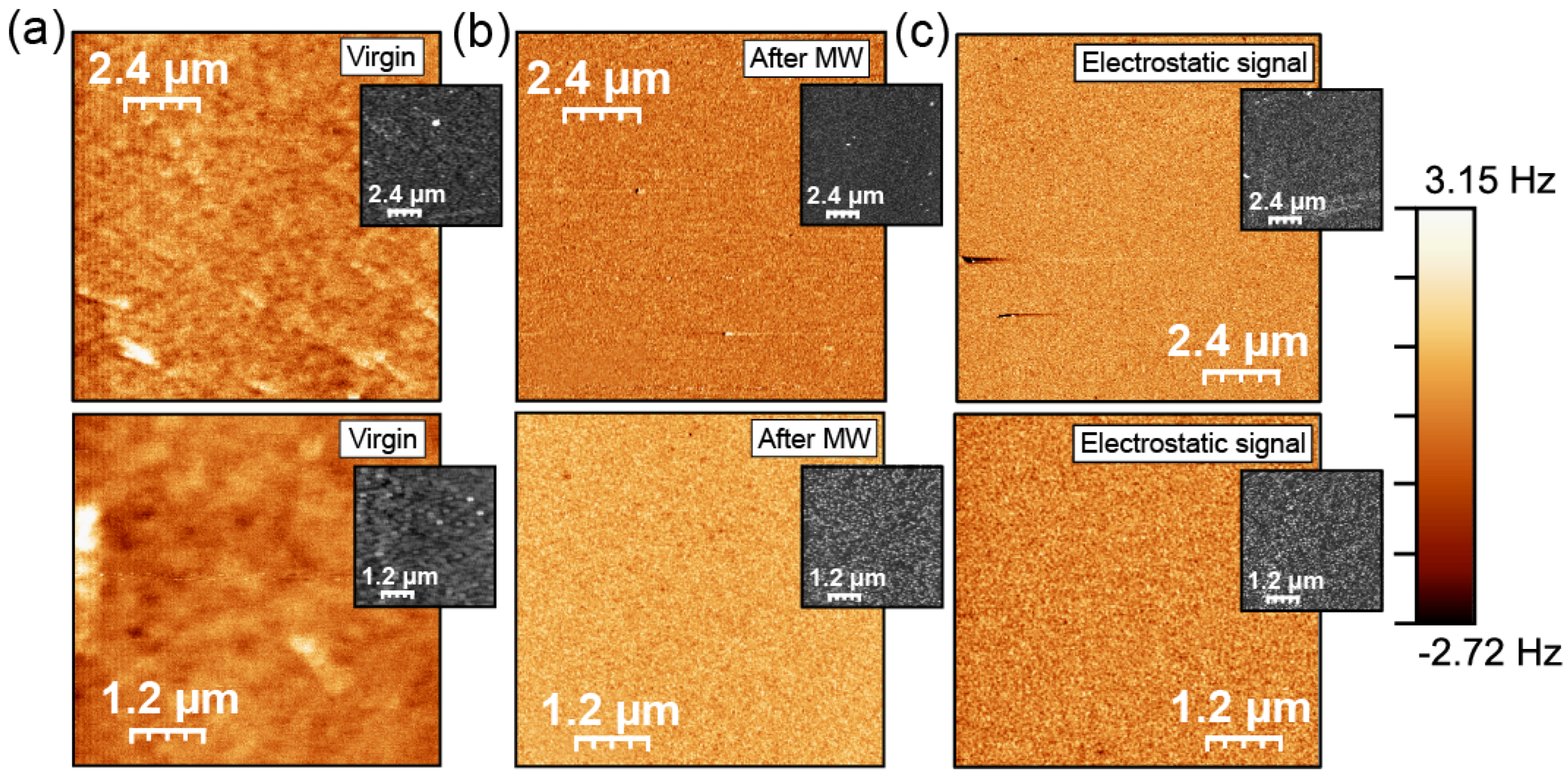
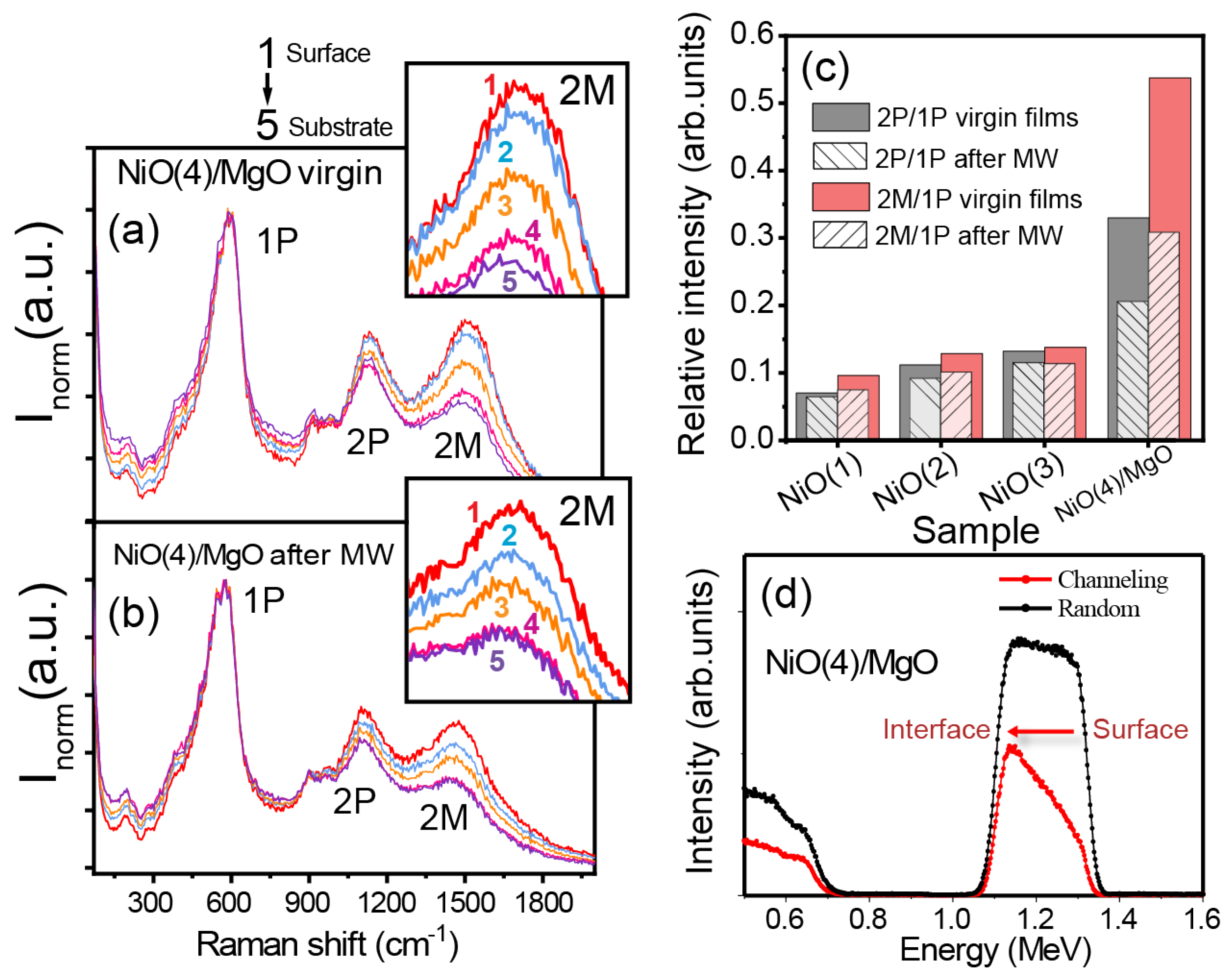

| NiO(1) | NiO(2) | NiO(3) | NiO(4)/MgO | |
|---|---|---|---|---|
| Substrate | AlO (0001) | AlO (0001) | AlO (0001) | MgO (100) |
| T(K) | 633 | 718 | 798 | 798 |
| PO(Pa) | ||||
| J (mA/cm) | 1.6 | 1.4 | 1.1 | 1.1 |
| E (eV) | 650 | 650 | 650 | 650 |
| Thickness (nm) | 244 | 228 | 195 | 207 |
| Deposition rate (A/s) | 0.33 | 0.33 | 0.27 | 0.26 |
| Lattice parameter (nm) | 0.428 | 0.423 | 0.426 | 0.425 |
Disclaimer/Publisher’s Note: The statements, opinions and data contained in all publications are solely those of the individual author(s) and contributor(s) and not of MDPI and/or the editor(s). MDPI and/or the editor(s) disclaim responsibility for any injury to people or property resulting from any ideas, methods, instructions or products referred to in the content. |
© 2024 by the authors. Licensee MDPI, Basel, Switzerland. This article is an open access article distributed under the terms and conditions of the Creative Commons Attribution (CC BY) license (https://creativecommons.org/licenses/by/4.0/).
Share and Cite
Caso, D.; Serrano, A.; Jaafar, M.; Prieto, P.; Kamra, A.; González-Ruano, C.; Aliev, F.G. Microwave Field-Induced Changes in Raman Modes and Magnetic Force Images of Antiferromagnetic NiO Films. Condens. Matter 2024, 9, 7. https://doi.org/10.3390/condmat9010007
Caso D, Serrano A, Jaafar M, Prieto P, Kamra A, González-Ruano C, Aliev FG. Microwave Field-Induced Changes in Raman Modes and Magnetic Force Images of Antiferromagnetic NiO Films. Condensed Matter. 2024; 9(1):7. https://doi.org/10.3390/condmat9010007
Chicago/Turabian StyleCaso, Diego, Aida Serrano, Miriam Jaafar, Pilar Prieto, Akashdeep Kamra, César González-Ruano, and Farkhad G. Aliev. 2024. "Microwave Field-Induced Changes in Raman Modes and Magnetic Force Images of Antiferromagnetic NiO Films" Condensed Matter 9, no. 1: 7. https://doi.org/10.3390/condmat9010007
APA StyleCaso, D., Serrano, A., Jaafar, M., Prieto, P., Kamra, A., González-Ruano, C., & Aliev, F. G. (2024). Microwave Field-Induced Changes in Raman Modes and Magnetic Force Images of Antiferromagnetic NiO Films. Condensed Matter, 9(1), 7. https://doi.org/10.3390/condmat9010007













